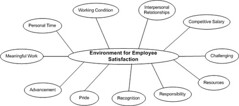 Approximately 25% of employees do not feel loyal to their current employer and 20% say they are likely to leave their current position to change jobs within a year, according to a recent CareerBuilder.com survey of HR professionals and hiring managers. Although I am not completely surprised by these figures, the percentages are nonetheless disturbing and warrant our attention. Ongoing recruitment, training and retention are costly endeavors on multiple fronts. Disengaged employees erode retention, productivity and profitability. Moreover, as with one bad apple, their attitudes tend to be infectious, spreading negativity to fellow employees, thereby further exacerbating the problem and escalating the overall damage. Far too many employees live in a state of comfortable misery and something must be done about this pervasive issue.
Approximately 25% of employees do not feel loyal to their current employer and 20% say they are likely to leave their current position to change jobs within a year, according to a recent CareerBuilder.com survey of HR professionals and hiring managers. Although I am not completely surprised by these figures, the percentages are nonetheless disturbing and warrant our attention. Ongoing recruitment, training and retention are costly endeavors on multiple fronts. Disengaged employees erode retention, productivity and profitability. Moreover, as with one bad apple, their attitudes tend to be infectious, spreading negativity to fellow employees, thereby further exacerbating the problem and escalating the overall damage. Far too many employees live in a state of comfortable misery and something must be done about this pervasive issue.
The bottom line is that employee dissatisfaction can largely be attributed to leadership skill and effectiveness. Of course individuals play a role and must assume some level of responsibility for their own satisfaction. But the reality is that it is up to us – right or wrong – to lead effectively, intelligently and passionately and as such inspire our teams to work in kind. The top reasons listed for disloyalty in CareerBuilder.com’s survey were: “I don’t feel my employer values me” (61%); “My efforts are not recognized or appreciated” (52%); “My employer doesn’t pay enough” (51%); and “Not enough career advancement opportunities” (44%). These are all issues over which we as leaders exercise a tremendous amount of control and influence. It is critical that we manage these areas purposefully and proactively.
We have to connect with our teams; our success depends on it. Michael Stallard captures the concept well, stating that “Unless the people in an organization have a strong sense of connection – a bond that promotes trust, cooperation, and esprit de corps – they will never reach their potential as individuals, and the organization will never reach its potential.” He suggests that we:
- Make a human connection with as many people as possible
- Treat and speak to employees as partners
- Help employees find the right roles
- Educate, inform, and listen to employees
- Decentralize decision making
- Recognize the human need for work/life balance
How are you encouraging loyalty in your teams? What are your retention rates and trends? When our teams are feeling invested, the end results extend far beyond individual performance. Beware: the converse is also true. Lead with passion and purpose to ensure engagement and long term satisfaction.
Nina Nets It Out: While we can’t fully control the decisions individuals will make, we can be mindful of the dynamics that foster satisfaction and retention, and proactively employ them with our teams. Inspiring loyalty isn’t difficult, but it does require awareness and commitment. Doing so will profit everyone in the end. Be sure to help all of your village members actively manage their careers.
Congratulations! This post was selected as one of the five best business blog posts of the week in my Three Star Leadership Midweek Review of the Business Blogs.
http://blog.threestarleadership.com/2008/10/01/10108-a-midweek-look-at-the-business-blogs.aspx
Wally Bock
Ironically, more often than not, it’s the best and the brightest who leave. To make matters worse, those who stay on seem to have little spirit left and are largely disengaged.
Hi Prem,
As you say, often times, the best and brightest are the ones to leave. As leaders, we must understand that it is just these people that we must convince to stay since they are frequently viewed as bellweathers for the others in the organization. Meaning, if they leave, others might consider leaving too, or as you point out, those that remain, do so with a reduced morale. So, the “so what” of this is that we must do all that we can to encourage these top performers to stay on and help create the better future that they wish to work within.